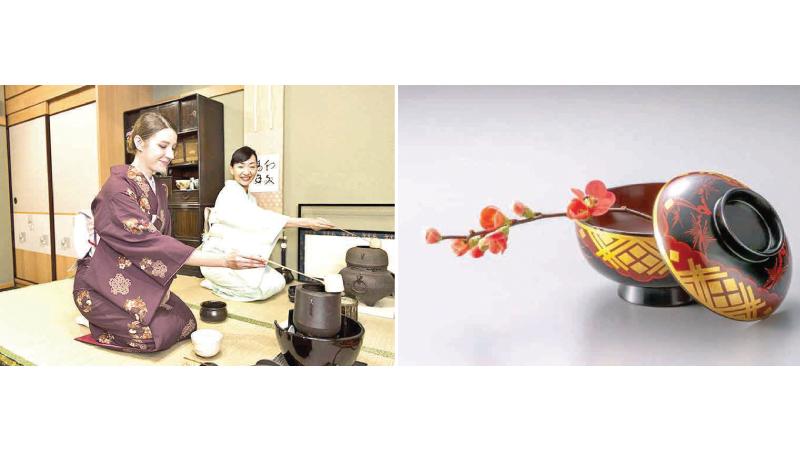
Japanese art was a source that provided the basis for creating beautiful patterns that amazed not only the Japanese people, but the entire world for centuries. This is largely due to the fact that almost all Japanese art forms feature simple designs that catch the eye of onlookers. This article is about the traditional Japanese art ranging from ‘Ikebana’, which contributed to the world of beautiful floral arrangements, to the ‘tea ritual’.
Shodo
 The most famous of the traditional Japanese art is called ‘shodo’. There are several variants of the fancy Japanese fonts that were brought from China during the Heian period about a millennium ago. The most popular of these, the ‘soso’ or ‘grass typeface’, is widely used to compose artistic or poetic manuscripts.
The most famous of the traditional Japanese art is called ‘shodo’. There are several variants of the fancy Japanese fonts that were brought from China during the Heian period about a millennium ago. The most popular of these, the ‘soso’ or ‘grass typeface’, is widely used to compose artistic or poetic manuscripts.
Letters written according to the ‘kaisho’ or ‘square pattern’ look like printed letters, and the letters written more quickly and without too much pressure on the brush are called ‘gyosho’ or ‘semi-I inscriptions’. In the early days, only the upper class had the opportunity to study the art of fine writing, but today it has become a compulsory subject in primary schools.
Flower arrangements- ‘Ikebana’
Unlike the brightly coloured intricate flower arrangements for sale on the sidewalks, the traditional Japanese flower arrangement, called Ikebana, is made using simple designs using almost all parts of a natural plant. Colour, form, order, and plant balance are considered to be the key elements of a successful ‘Ikebana’ flower arrangement.
Ikebana flower arrangements, which have a history of over seven centuries, are of several types. Flower arrangements using flowers with long stems are known as ‘Rikka’, while those using living plants are called ‘Seika’ or ‘Shoka’, and flower arrangements using a thin tall pot are called ‘Nagaire’. If the shape of the pot resembles a dish, these flower arrangements are also known as ‘moribana’.
‘Ukiyo’ wood mold printing
 The art of painting using wooden molds known as ‘Ukiyo’, meaning ‘pictures of the floating world’, originated in the late 16th century. The art of ‘Ukiyo’, originally used to paint everyday life in Kyoto, spread throughout Japan as a popular art form by the 18th century.
The art of painting using wooden molds known as ‘Ukiyo’, meaning ‘pictures of the floating world’, originated in the late 16th century. The art of ‘Ukiyo’, originally used to paint everyday life in Kyoto, spread throughout Japan as a popular art form by the 18th century.
Beginning with simple paintings using only black paint, the art of ‘Ukiyo’ has gradually evolved into incorporating not only a variety of colours but also complex paintings. According to the art of ‘Ukiyo’, there are three main steps to follow when creating a painting. Accordingly, a painting must be engraved on a wooden board. Finally, the wooden mold is painted with coloured ink and pressed onto a piece of paper.
‘Shikki’
Due to its beauty and durability, the world-famous Japanese art form has been around for millennia, with the primary purpose of preserving the natural beauty of the wood used to create the goods. Shikki is often made of coloured wood or oak. The Japanese decorate the finished wood with a colourful painting before applying the resin, and the finish is always shiny and delicate.
‘Tea ritual’
The ‘tea ritual’ practised by the Japanese aristocracy during the Hayne period about a millennium ago, when serving tea to high-ranking guests, has now become a traditional practice over time.
In performing the ‘tea ritual’ of serving green Japanese tea called ‘Machcha’ with traditional Japanese sweets, the full attention of the tea presenters should be focused only on a few specific movements, the primary purpose of which is not the tea drink but the aesthetic pleasure enjoyed by the viewer making the tea pot. Similarly, those who prepare tea in the ‘Tea Ritual’ do so from the traditional tea room, dressed in a brightly coloured robe and with a ‘tatami’ mat.
The art of ‘kodo’
Smelling and appreciating the scent of Japanese incense sticks is called ‘kodo’. A Buddhist ritual during the Nara period began with the burning of fragrant firewood in temples. Since natural scented wood was extremely rare and sometimes took centuries to absorb the scent into the woods, the Japanese began producing incense sticks, which they believed would bring the benefits of sharpening the five senses, cleansing the body and mind, increasing alertness and eliminating loneliness
